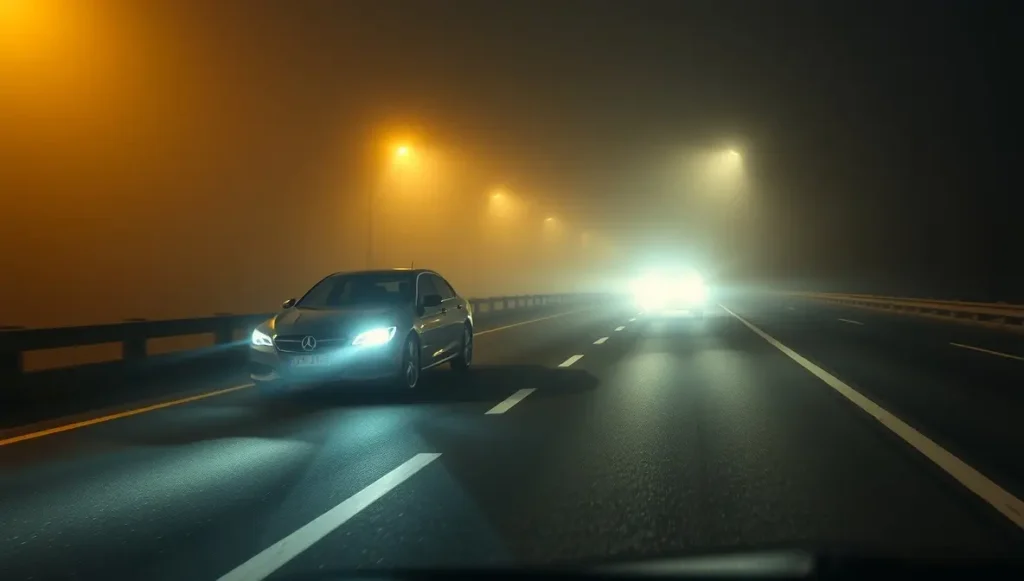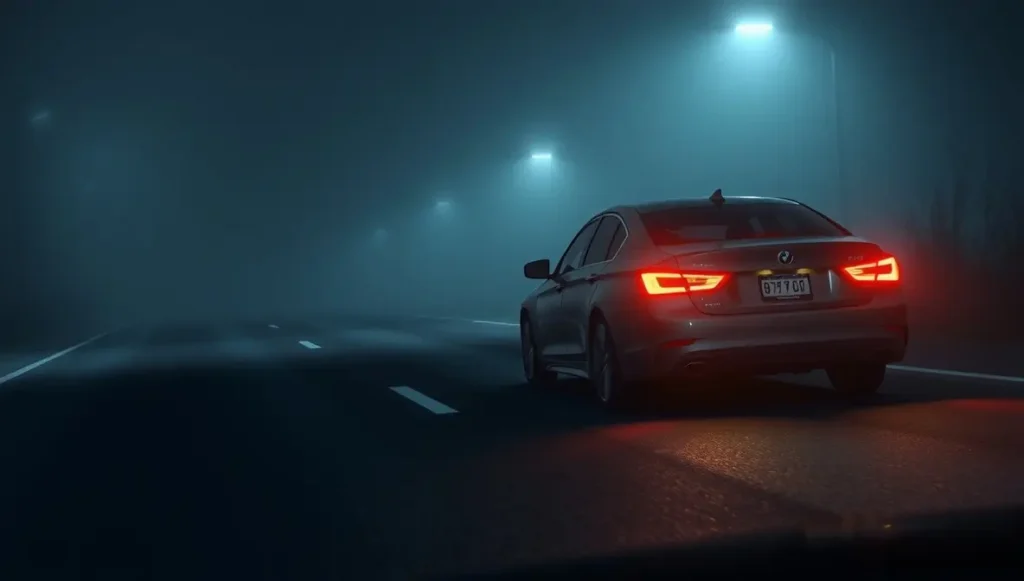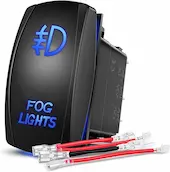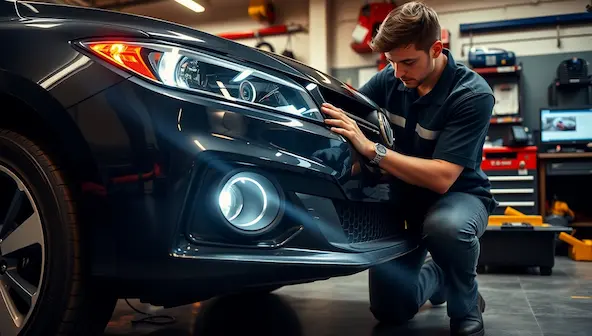Seventeen years in my shop have taught me one thing about fog lights: most drivers get them wrong. I’ve watched customers roll in with their switches permanently on, blinding other drivers on clear nights. I’ve also seen folks white-knuckling their way through a pea-soup fog, never realizing their car has a dedicated tool for exactly this situation.
This isn’t just a theory; it’s what I see on the lift and in the service bay every week. Headlights are for darkness. Fog lights are for something else entirely—they’re your tool for seeing and being seen when the weather turns foul.
Consider this your master class. We’re going to move beyond the basic owner’s manual and dive into the real-world mechanics and laws. I’ll show you the precise situations where that switch can be a lifesaver, walk you through the common failures I diagnose daily, and break down the right way to install a set, whether your car is pre-wired or not. My goal is simple: to give you the confidence to use this vital safety feature correctly and legally on American roads. Let’s get started.
What Are Fog Lights? Cutting Through the Confusion
From my view in the service bay, I define fog lights as your low-visibility specialists. While your headlights are your everyday workhorses for seeing far down the road, fog lights are the tool you deploy when that road disappears. They’re not just “extra headlights.” Their entire design is a deliberate engineering solution to a specific problem.

Mounted low on the bumper, they fire a wide, flat, and sharp-cut beam. This isn’t an accident. Think of fog as a blanket hanging in the air. Your headlights, mounted higher up, hit that blanket and reflect a wall of glare right back at you. Fog lights, mounted low, shoot under the blanket, illuminating the road surface and the lane markings just ahead of you without that blinding bounce-back.
Let’s get straight to the questions I hear from drivers in my shop:
“When am I actually supposed to use these things?”
You hit that switch when visibility genuinely drops – I’m talking dense fog, a torrential downpour, or a snowstorm when visibility drops to a few car lengths. Their job is to light up the immediate 10 to 25 feet in front of your tires, helping you stay in your lane and spot curbs or debris your headlights are missing.
“What’s the law? I don’t want a ticket.”
Here’s the mechanic’s truth: the law follows the logic. In the U.S., the rule isn’t about having them, but about using them correctly. Legally, you should only have them on when visibility is severely reduced. Blasting them on a clear night isn’t just rude; it’s often illegal because you’re dazzling oncoming traffic. I’ve had customers get pulled over for exactly this.
“How do I even turn them on in my car?”
This one trips up many. On most modern cars, you can’t just turn on the fogs alone—it’s a safety feature. First, turn on your parking lights or low-beam headlights. Then, look for a separate switch on the stalk or dashboard, often marked with a symbol of a lamp with a wavy line through it. Pull or twist it, and a matching green indicator will light up on your dash.
One Pro Tip from the Garage

Many European-brand cars and some newer domestic models have a rear fog light. It’s a single, blazingly bright red light that makes you massively more visible from behind in a white-out. It uses a different switch, often with the lamp symbol pointing to the right. If you see that symbol, use it—it prevents rear-end collisions. But for heaven’s sake, turn it off when the fog clears. Drivers behind you will thank you.
How Fog Lights Work: A Mechanic’s Look Under the Hood
Forget the complex schematics for a minute. In my shop, I explain fog light operation like a simple relay race for electricity. It’s a team effort where each component has a specific job, and if one fails, the whole system lets you down.
Here’s the real-world sequence of how power gets to your fog lights, the way I trace it with a multimeter:

- The Source (Battery): It all starts here. This is the power reservoir for the entire car.
- The Trigger (Parking/Low-Beam Circuit): This is a crucial safety step. Your fog lights can’t work alone; they need a signal from your parking or low-beam headlights to activate. This prevents you from accidentally leaving them on and ensures they’re part of a complete lighting system.
- The Protector (Fuse): This is the weak link designed to save the rest of the system. If a power surge happens—say from a short circuit—this small component sacrifices itself by blowing, cutting power to prevent a meltdown.
- The Muscle (Relay): Think of the relay as a heavy-duty switch. Your dashboard switch only sends a tiny signal. The relay hears that signal and clunks (you can sometimes hear it), connecting the battery’s full power directly to the fog lights. It does the heavy lifting so your small switch doesn’t have to.
- The Command (Switch): This is your control. You press it, it sends the “go” signal to the relay.
- The Light (Bulbs): Finally, the power arrives, and the bulbs (halogen, LED, or HID) produce that characteristic wide, low-cut beam.
A Note on Modern vs. Old Cars
On an older car, this is a straightforward, physical circuit I can trace with my hands. On virtually all new cars, it’s smarter. The switch talks to the car’s main computer (the CAN bus system), which then decides if all the conditions are right to send the command to the relay. It’s more integrated, but also more complex to diagnose.
Mechanic’s Golden Rule
When a customer comes in with one or both fog lights out, my first move after checking the fuse is rarely the bulb. I head straight for the ground connection. In my 17 years, I’d say 8 out of 10 fog light failures are due to a loose or corroded ground wire where it bolts to the chassis. It’s the most common point of failure and the easiest to fix. A quick clean and tighten often brings them right back to life.
Common Fog Light Issues and Solutions
Fog lights are built tough, but they face harsh weather and road conditions, so problems happen. Here’s a list of common issues and how to fix them — for both front and rear fog lights.
| Problem | Likely Cause | Solution |
|---|---|---|
| Fog lights not turning on | Blown fuse or bad relay | Replace fuse/relay and check wiring continuity |
| One light dimmer than the other | Corroded ground wire | Clean terminals and retighten |
| Both lights flicker | Faulty switch or relay | Test with a multimeter and replace faulty part |
| Rear fog light stays on | Stuck relay or wiring short | Check switch and relay operation |
| Fog light lens fogging up | Moisture or poor seal | Remove light, dry with low heat, and reseal with silicone gasket |
Pro Tip: When replacing fog bulbs, avoid touching the glass with bare fingers. The oil from your skin can cause premature burnout.
How to Install Fog Lights in a Car
Installing fog lights depends on your vehicle’s make and model. Here’s how to approach it safely for both older and newer cars.
For Older Cars (Manual Setup)

- Mount the fog light housings on the lower bumper, aiming slightly downward.
- Run a 12V power line from the battery through an inline fuse to the relay.
- Connect the relay trigger to the parking light circuit (so fogs only work with lights on).
- Ground the fog lights to the chassis.
- Install a manual switch inside the cabin, ideally near the steering column.
- Test the circuit — both lights should turn on evenly.
For Newer Cars (Computer-Controlled Systems)
- Check if your car already has pre-wired fog connectors (many newer models do).
- If yes, simply install OEM fog light kits and enable the function through the OBD diagnostic tool or dealer software.
- If no, use a CAN-bus-compatible relay harness to avoid triggering dashboard errors.
- Always seal connections properly — newer systems are sensitive to voltage drops.
Expert Advice: For maximum performance, align your fog lights so their beams sit just below your low-beam range — this prevents glare while lighting the road perfectly.
FAQs
Can I drive with fog lights on?
You can drive with fog lights on only during poor visibility — fog, mist, snow, or heavy rain. In clear conditions, it’s illegal in some states and can distract other drivers.
What is the rule for fog lights?
In the USA, FMVSS 108 regulates fog lights. You can use them as auxiliary lights but only when visibility is seriously reduced. Never use them instead of your headlights at night.
Do fog lights help in snow or rain?
Yes, but only to an extent. Fog lights can improve road surface visibility in snow or rain, but they won’t replace headlights. Their job is to reduce glare and light up the close-range road area.
Final Word from the Garage
In my 17 years as an electromechanic, I’ve learned that the most critical safety features are the ones you hope you never need. Fog lights top that list. They are your dedicated tool for when conditions turn from bad to dangerous, cutting a clear path forward when standard headlights fail.
Don’t wait for a white-knuckle drive in a downpour to discover yours are faulty. Make it a habit to test them monthly. That quick check and the knowledge in this guide empower you to tackle common issues head-on. Remember, true safety on the road isn’t just about reacting—it’s about being proactively prepared. See clearly, drive safely.

Pingback: EPC Light on Car: What It Means & Pro Fixes (2025 Guide)